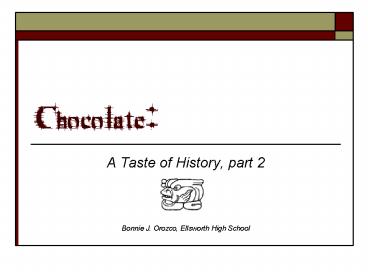Chocolate: - PowerPoint PPT Presentation
1 / 16
Title:
Chocolate:
Description:
The word chocolate is used in modern Maya communities to refer to ... him as a member of the high nobility, deriving great prestige from the use of the vessel. ... – PowerPoint PPT presentation
Number of Views:61
Avg rating:3.0/5.0
Title: Chocolate:
1
Chocolate
- A Taste of History, part 2
- Bonnie J. Orozco, Ellsworth High School
2
- Is cacaochocolate?
- How do we know?
- How do you read a glyph?
- Study epigraphy, the field of deciphering
ancient inscriptions.
3
Cacao Kakaw
- The word cacao is a Spanish adaptation of the
word kakaw. The word chocolate is used in modern
Maya communities to refer to substances created
from ground cacao seeds, although this may be a
result of Spanish influence. - Chocolate is a Spanish adaptation of the Nahuatl
word chocolatl. - The word chocolatl comes from a combination of
the terms choco ("foam") and atl ("water") as
early chocolate was only consumed in beverage
form.
4
Anthropology or Archeology?
- How do we learn about ancient cultures?
- Anthropology
- scientific study of the origin, and the
physical, social, and cultural behavior of man. - Archaeology
- systematic recovery and study of material
evidence remaining from past human life and
culture, such as buildings, tools, pottery and
tombs.
5
Olmecs, Mexica, Maya
- What civilizations drank chocolate?
- What did crushed cacao taste like?
- What did cacao/chocolate represent
- for these cultures?
Altar de Sacrificios during excavation in 1961
6
Anthropologists discovered
- the ancient Maya drank chocolate drinks out of
vessels like this one found at Altar de
Sacrificios, Guatemala. - glyphs on this vessel tell a storythat dates to
the year 754.
7
Dates and Mayan numbers
- The Mayan numbering system is base 20
- Dots and lines represent numbers
- The numbers are read vertically. This is the same
way that Mayan glyphs are read.
8
How does it work?
First draw a box around each of the places
of the numbers so you (and I) won't get confused.
- Lets add 37 and 29
9
Museo del Popol Vuh
Ceramic clay vessels, early classic period
(300-600AD) Maya of Guatemala An analysis
discovered residue of ancient beverages inside
the containers.
10
Ceremonial vessels from tombs
- found in the Maya sites in Guatemala and Belize
dating from the Middle Pre-classic period
(1000-400BC).
- Museo Nacional de Antropológia, Ciudad de
Guatemala, Guatemala.
11
Diosa de cacaoDios joven del cacao.
- the ancient Maya formed ceramic vessels with the
gods and goddesses who seem to personify the
tree, since their bodies seem to sprout abundant
cacao pods.
12
Vasija para bebida de cacaocontainer for
chocolate drink.
Museo del Popol Vuh.
- Chemical analysis of residues also confirm the
veracity of hieroglyphic texts written on Classic
Maya vases that often explain their function as
cacao drinking vessels. This is clear from glyphs
drawn on the lid of the tripod vase, decorated
with painted stucco. - The inscription reads
- Yukib tayutal kakaw
- (this is) the vase for the cacao beverage of
king (personal name), the ninth successor
13
- The text of this vase hints at the variety of
cacao beverages that were used in the Maya
lowlands. - The text usually ends with the owners name,
whose titles exalt him as a member of the high
nobility, deriving great prestige from the use of
the vessel.
14
Chocolate cup-- what do you see depicted?
- A young cacao god appears in lowland Mayan art,
with cacao pods sprouting from the body. - He has been associated with the Maize god, and
his body marked as a tree. This suggests that he
could be one of the four trees that stood at the
four world directions in Mesoamerican thought and
the Mayan cosmology. - What myth is shown here?
- Escena mitológica con arbol de cacao. Altiplano
Norte, periodo clasico tardio (600-900dc)
15
Cacao important because
- the uses of the cacao tree extend beyond basic
consumption of a foamy beverage oil from the
seeds (better known as cacao butter) can be used
as a cream and various parts of the tree are used
in medicines. - What other characteristics of the cacao pod or
its liquid made it an important element in Mayan
culture? And today?
Photo courtesy Hawaiian Vintage Chocolate
16
Sources
- Linda Stradley. http//whatscookingamerica.net/Bev
erage/HotChocolate.htm - Dr. Brent Metz. Assistant Professor of
Anthropology, University of Kansas. - Hersheys. http//www.hersheys.com/discover/chocol
ate.asp - http//home.howstuffworks.com/chocolate1.htm
- http//www.cacaoweb.net/nutrition.html
- The Math Forum. Drexel University.http//mathforum
.org/k12/mayan.math/mayan3.html - The American Heritage Dictionary, Second College
Edition. Houghton Mifflin Co. 1982. - Science Museum of Minnesota. http//www.smm.org/sl
n/tf/c/chocolate/chocolate.html - Kakaw, el chocolate en la cultura de Guatemala.
Museo Popol Vuh, Universidad de Francisco
Marroquín, Guatemala. 2005. - Presentación. Michael D. Coe, Profesor Emerito de
Antropologia, Yale University. - Etnobotanica del Cacao. Camero L. McNeil.
- Tierra de Cacao. Oswaldo Chinchilla Mazariegos
- Chocolatera Nuez de
coco incisa, con guarniciones de plata.
Posiblemente del siglo XIX.
Altura 15.5 cm ancho 11 cm.

